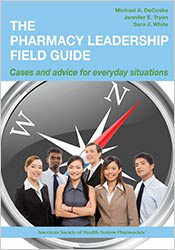Food and Drug Administration
October 5, 2015Christopher Topoleski
Director, Federal Regulatory Affairs
ASHP
Good afternoon. My name is Chris Topoleski, and I am the Director of Federal Regulatory Affairs at ASHP. ASHP represents pharmacists who serve as patient care providers in acute and ambulatory settings. The organization’s more than 40,000 members include pharmacists, student pharmacists, and pharmacy technicians. For over 70 years, ASHP has been on the forefront of efforts to improve medication use and enhance patient safety.
I appreciate the opportunity to present the views of ASHP’s members regarding improved communications about REMS and their requirements.
ASHP is a strong advocate for improving patient safety and medication management. We believe that the development of consistent, evidence-based medication use systems is central to achieving safe medication use.
Acknowledgement
We would like to recognize the significant number of improvements made to the REMS program over the past five years, including the discontinuation of a significant number of REMS, development of the Shared System REMS, release of the Guidance document for medications guides, and the continued interest of the FDA in working with stakeholders, as evidenced by this meeting.
Our members recognize the potential risks of medications that are inappropriately prescribed, dispensed, and monitored, as well as their own responsibility to provide patients with comprehensible information that is useful to both the patient and the provider.
As noted in past ASHP comments to the FDA, we believe educating patients is clearly important, and we appreciate the intent of the FDA to improve communications to pharmacists and other professionals about REMS and their requirements. ASHP believes that a greater understanding of the limitations of current communications between the FDA and healthcare professionals could be reached if the agency asked pharmacists and other providers the following questions:
- When new REMS medications are released, do you feel FDA communication to the marketplace is adequate?
- When there are changes to REMS, do the FDA and manufacturers provide effective communications regarding these changes?
- Is REMS information easily accessible to determine what your responsibilities are as a clinician including any associated documentation?
- Are there cases where patient care has been negatively impacted due to a REMS?
- Are there situations where REMS requirements have caused prescribers to not use a particular product?
- Is the content of REMS-required patient education sufficient, and at the right literacy level and frequency?
As discussed in a previous FDA meeting on standardization of REMS materials, ASHP encourages the
FDA to work toward a centralized electronic means for all REMS and the various registration, provider education, and patient documentation requirements. This effort could eliminate redundancies that exist and the need to maintain separate paper record keeping in thousands of patient care settings. This should include mechanisms to routinely and proactively inform practitioners on changes to REMS programs. Though the core components REMS are standard, the elements within each component should be analyzed in an effort to standardize.
The FDA should take into considerations ASHP’s experience with our REMS Resource Center when developing communication materials. We developed this resource in 2009 when no other REMS resource was available to help healthcare professionals access and understand REMS information. The Resource Center answers the following questions that healthcare providers may have:
- Why is REMS required?
- Does a hospital have to register?
- Does a patient have to register?
- Does a prescriber have to enroll?
- Do I have to verify that the patient and prescriber are enrolled?
- Do I have to provide a Med Guide?
- Is monitoring involved?
- Can I order medication through usual suppliers?
- What do I have to document?
- Am I required to complete C.E.?
- Are there restrictions on dispensing amounts?
- Am I subject to an audit?
ASHP believes that the goal for most REMS is not to achieve zero risk, but rather to provide information to pharmacists and other providers in a timely manner to support a risk-benefit discussion and decision. For example, for some drugs, acceptable risk depends on patient-specific factors that range from disease severity and failure of alternative therapies, to an individual’s personal risk tolerance.
Conclusion
In conclusion, ASHP appreciates the opportunity to comment and participate on the further improvements of the REMS programs and appreciate the FDA’s efforts to engage stakeholders in the process.


